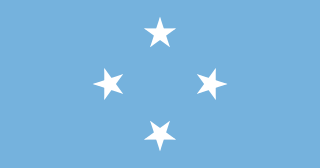
The Federated States of Micronesia, or simply Micronesia, is an island country in Oceania. It consists of four states – from west to east, Yap, Chuuk, Pohnpei and Kosrae – that are spread across the western Pacific. Together, the states comprise around 607 islands that cover a longitudinal distance of almost 2,700 km (1,678 mi) just north of the equator. They lie northeast of Indonesia and Papua New Guinea, south of Guam and the Marianas, west of Nauru and the Marshall Islands, east of Palau and the Philippines, about 2,900 km (1,802 mi) north of eastern Australia, 3,400 km (2,133 mi) southeast of Japan, and some 4,000 km (2,485 mi) southwest of the main islands of the Hawaiian Islands.

The Federated States of Micronesia are located on the Caroline Islands in the western Pacific Ocean. The history of the modern Federated States of Micronesia is one of settlement by Micronesians; colonization by Spain, Germany, and Japan; United Nations trusteeship under United States-administered Trust Territory of the Pacific Islands; and gradual independence beginning with the ratification of a sovereign constitution in 1979.

This article is about the demographic features of the population of the Federated States of Micronesia, including population density, ethnicity, education level, health of the populace, economic status, religious affiliations and other aspects of the population.

Micronesia is a subregion of Oceania, consisting of thousands of small islands in the western Pacific Ocean. It has a close shared cultural history with three other island regions: the Philippines to the west, Polynesia to the east, and Melanesia to the south—as well as with the wider community of Austronesian peoples.

A rai stone, or fei stone is one of many large artifacts that were manufactured and treasured by the native inhabitants of the Yap islands in Micronesia. They are also known as Yapese stone money or similar names.

The traditional music of the Federated States of Micronesia varies widely across the four states, and has, in recent times, evolved into popular music influenced by Europop, country music and reggae.

Yapese is a language spoken by the people on the island of Yap. It belongs to the Austronesian languages, more specifically to the Oceanic branch of that family. It has been difficult to classify it further, but Yapese may prove to be one of the Admiralty Islands languages.

The State of Yap, also known in the Yapese language as "Nam nu Wa'ab" or simply as Wa'ab, is one of the four states of the Federated States of Micronesia (FSM). The other states are Kosrae State, Pohnpei State, and Chuuk State.
Dinay is a village belonging to the municipality of Rull in the southern part of the island of Yap in the Federated States of Micronesia. The village was added to the United States National Register of Historic Places in 2004. It is unique in Micronesia as the site of an ancient pottery complex, and is probably one of the earliest settlements on the island. The ancient village complex includes more than a dozen family platforms (daf) of such age that local folklore has forgotten their lineages, normally a significant cultural feature of such sites. The period of occupation is estimated to have been between about 3000 BCE and 1600 CE.
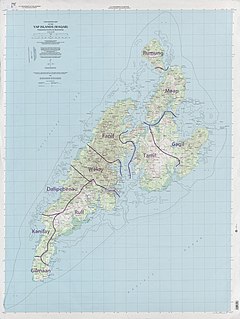
Rull is a municipality in the southern part of the island Yap, Federated States of Micronesia. It has a traditional dancing ground. Rull has a population of 1,847. The historic Rull Men's Meetinghouse is located within the town.
David Dean O'Keefe was an Irish-American ship captain who become a historical and political figure on the Western Pacific island of Yap.
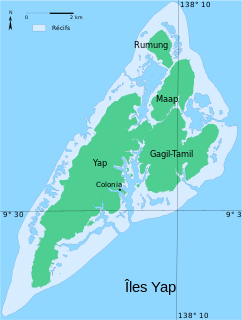
Yap traditionally refers to an island group located in the Caroline Islands of the western Pacific Ocean, a part of Yap State. The name "Yap" in recent years has come to also refer to the state within the Federated States of Micronesia, inclusive of the Yap Main Islands and its various outer islands, the Yap Neighboring Islands. For specifying the island group, the name Yap Main Islands is most exact.

Fanif is a municipality in the state of Yap, Federated States of Micronesia. Fanif encompasses the northwesternmost part of the main island and is the location of Yap proper's highest point, Mount Taabiywol, at 178 meters/584. Gilfith is the head village of Fanif. Fanif straddles the northern part of the main Island of Yap and includes the villages of Yyin, Quayrech, Ruunuw, Wuluuq, Malawaay, Rumuuq, Qatliw, and Raeng. It has two elementary schools, Fanif and North Fanif. A paved road runs through the villages along the northwest coast of Fanif into Weloy to the South and connecting into the Tomil - Colonia Road to the Northeast. The west coast is also accessible by boat from Colonia via the Tagireeng Canal.
T
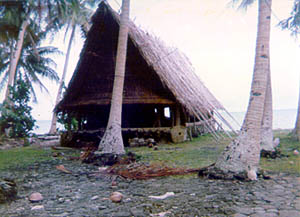
The Rull Men's Meetinghouse is a historic meeting house in Rull, a village on the island of Yap in the Federated States of Micronesia. It is a large rectangular structure, set on a raised stone platform. The flooring consists of treated betelnut palm trunks, and has a steeply pitched roof made of bamboo supports with various types of tropical leaves tied in place using coconut fiber. The faluw, although not the first built on this platform, has historically occupied a central place in the civic life of the community, serving as a place where the men of the village could meet in seclusion, and as a place for social rites.
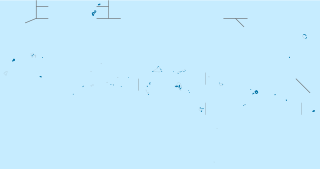
The Spanish Fort in Colonia, the capital of Yap State in the Federated States of Micronesia, is a historic seat of power on the island of Yap. Only foundational remnants of the 19th-century Spanish fortification survive, on a property now occupied by the local government. The site was also where German and Japanese administrators had their headquarters during their respective periods of administration in the decades of the 20th century before World War II. The foundation was built of stone and cement, and is still accessible via its original steps.

The Yapese people are a Micronesian ethnic group native to the main island of Yap. Under different administrative rules, Yapese culture has been influenced by Spanish, Japanese, German, and American cultures. Aspects of traditional Yapese culture are still important in modern Yapese culture.

Yap Day is a legal holiday in Yap State, one of the four states of the Federated States of Micronesia (FSM), held annually on March 1. It is a celebration of traditional Yapese culture. Common activities held during this time include competitions and traditional dances.

The Church of Jesus Christ of Latter-day Saints in the Federated States of Micronesia refers to The Church of Jesus Christ of Latter-day Saints and its members in the Federated States of Micronesia (FSM). The first known missionaries arrived on July 5, 1978. As of December 31, 2019, there were 6,307 members in 24 congregations in FSM. The LDS Church has congregations in every state in the FSM.
Yap Living History Museum is a museum in Colonia, Yap, in the Federated States of Micronesia. It is a living history museum which is dedicated to Yapese culture.













